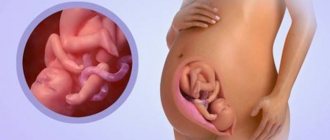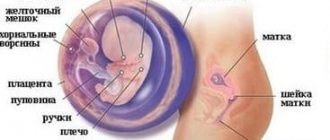Pregnancy is a real fireworks display of positive emotions and at the same time a colossal burden on the female body. At different stages of pregnancy, a woman experiences some difficulties, which in most cases are not dangerous and are accompanied only by a certain discomfort. Along with toxicosis, lower back pain and migraines, complaints of soreness in the perineum during pregnancy are often recorded during pregnancy. In 90% of cases, these are normal physiological phenomena in bone and muscle tissue due to excessive stress. But we should not exclude the risk of pathology, which is rare, but still occurs. Therefore, consultation with a gynecologist should be mandatory in order to diagnose the inflammatory process in time. This disease does not affect pregnancy, but it can create many difficulties during the delivery process. Let's look at all the possible causes of pain in the perineum, how you can fix the problem yourself, and whether treatment is necessary in this situation.
Pain in the perineum during pregnancy - normal or pathological?
Pain, regardless of the nature of its origin, always signals various disorders in the body. It can appear as a result of serious illnesses or be temporary and go away on its own after the irritant is eliminated. Pain in the perineum is precisely the latter type of pain, which is caused by a strong load on the muscles and bones in the pelvis. This happens especially often if a woman did not play much sports before conception and her ligaments and muscles are not elastic. After childbirth, the pain goes away as the root cause of its occurrence eliminates itself.
In some cases, intense pain in the perineum may be unnatural and appears due to an acute inflammatory process in the muscles or bone tissue. To confirm the diagnosis, the woman immediately undergoes an examination and, if necessary, a course of anti-inflammatory therapy. Timely treatment helps eliminate the pathological process and then the woman will be able to give birth on her own. If the inflammation progresses, the woman is referred for a caesarean section. Natural delivery may result in pelvic separation or severe muscle damage.
In the later stages
The closer the time of birth, the more painful sensations appear. When the belly has already grown significantly, and the mother is in the last months of pregnancy, the source of pain in the perineum may be the natural process of separation of the pelvic bones. This happens to make it easier for the baby and mother during childbirth. Usually the pelvic muscles are so elastic that they do not have time to stretch following the separation of the bones, which is why nagging pain in the perineum occurs. In this situation, nothing can be done; you will have to be patient, because no pain can compare with the joy of the appearance of a long-awaited son or daughter. Such pain usually appears at 35-36 weeks of pregnancy. Painful sensations in the perineum in the last stages are a kind of harbinger of childbirth. The baby has already grown and is actively preparing for birth, dropping lower and putting pressure on the bones, muscles and organs of the abdominal cavity.
But in the third trimester, not only bone separation and muscle strain can cause unpleasant pain in the perineum. In addition, swelling may also occur, which is understandable, since the pressure of the child’s weight makes it difficult for blood to flow from the genitals, the veins become compressed, which can cause a feeling of heaviness and hemorrhoids. The cause of this may also be pinching of the sciatic nerve, which results in sharp spasmodic pain in the perineum. Also, in such a situation, it will be difficult for a woman to move and walk; every step will be felt in the perineum by sharp pain. Turning from one side to the other will cause a lot of discomfort. Despite the fact that the pain when the sciatic nerve is pinched can be very severe, doctors try not to treat this condition and advise the expectant mother to endure it, since after childbirth it will go away on its own.
But the causes of pain in the perineum can also be more serious diseases that require treatment. These include loosening of ligaments and varicose veins of the perineum. Therefore, you should not hope that everything will go away on its own, and any painful condition should be discussed with your doctor, who will determine whether the pain is a sign of a normal pregnancy or requires medical measures.
In the vast majority of cases, after childbirth, pain in the perineum goes away forever, but this only happens in cases where the woman did not have perineal ruptures during childbirth, otherwise the pain will continue to be present for some time.
Causes of pain in the perineum during pregnancy
In the early stages of gestation (up to 20 weeks), pain and tingling in the perineum should be absent. Their appearance almost always indicates a serious problem. Therefore, contacting a gynecologist at the first painful sensations is extremely necessary. The doctor must rule out complications that threaten pregnancy.
Why does the perineum hurt in early pregnancy?
Provocateurs of pain that radiates to the perineum during pregnancy in the first few weeks of pregnancy are:
- Risk of miscarriage. In this situation, the cervix dilates and the bone corset in the pelvis slightly diverges. Pain in this place may be the first and even the only signal of an incipient miscarriage. But timely contact with an obstetrician-gynecologist in 80% of cases helps prevent the loss of a baby.
- Varicose veins of the pelvic organs. If a woman experiences rapid expansion of varicose veins, she may feel severe discomfort. She seems to have a tingling sensation in the perineum during pregnancy, there may be a feeling of “pins and needles”, numbness. Such sensations occur as a result of circulatory problems. This disease must be treated immediately, since the appearance of a dense venous network may be accompanied by internal bleeding in the pelvis or fetal hypoxia.
- Purulent inflammation in the muscle tissue of the perineum. Pregnancy causes a decrease in immunity. Therefore, even microtraumas on the genitals or in the inner thighs can become a “gateway” for infection. It can get from the outside, for example, from clothes, through dirty hands, when visiting a swimming pool, or from the anus. Harmful microorganisms can become active and severe suppuration will begin in the form of furunculosis, acne, and purulent wounds. If left untreated, the infection will spread to the uterine cavity and to the baby. Complications can range from fetal infection to sepsis.
- Hypertonicity of the uterus. In the early stages this phenomenon is very common. With treatment, the uterine tone subsides, and the woman calmly continues to bear the baby. An increase in tone can be suspected by a characteristic symptom: a woman feels that there is pressure in her perineum during pregnancy.
Pain in the perineum at this gestational age always has serious reasons for examination, so there is no need to neglect a visit to the doctor.
What causes pain in the perineum in the 2nd and 3rd trimester
Starting from the 4th month of pregnancy, pain in the perineum is classified as a short-term functional disorder. As a rule, pain persists from 34 to 40 gestational weeks, but can occur at 20-25 weeks and continue for another 1-2 months after birth.
The cause of pain in this area may be the following physiological characteristics of a pregnant woman:
- Excessive activity of the baby. If the fetus often moves its legs over a long period of time, it rests against the fundus of the uterus and presses on the muscles of the perineum. They can be greatly stretched and even partially injured. But this does not threaten either the mother or the fetus and does not affect the process of delivery. It’s just that a woman often notes that her perineum feels tight during pregnancy and she feels as if something is bothering her in the pubic area.
- Decreased physical activity. In the absence of the necessary load on the muscular system, a woman quickly gains excess weight, the muscles of the perineum lose elasticity, become flabby and are easily injured when walking under the pressure of a large uterus. During the process of delivery, this provokes multiple ruptures.
- Hormonal changes. According to the law of nature, which is genetically inherent in the female body, a change in hormonal levels occurs. This process controls the softening of the bone tissue in the hip area so that the fetus can be born without damaging the mother's bones. This is why the bones of the perineum hurt during pregnancy. But the pain is periodic and quite tolerable.
- Polyhydramnios or excess fetal weight. Both of these factors increase pressure on the walls of the uterus, under the weight of which the muscles are stretched. In this case, a woman may constantly experience discomfort in the perineum.
- Approaching birth. Closer to delivery, the baby is positioned with its head towards the exit, and the cervix itself begins to gradually soften, preparing to let the fetus pass. This contributes to compression of the vascular network and nerve fibers, which causes pain in the perineum after 37 weeks of pregnancy.
All of the above factors are completely normal and often occur during pregnancy. No special treatment or additional examinations are performed. And in order to improve a woman’s well-being and reduce the risk of trauma to the perineum during childbirth, it is recommended to do light gymnastic exercises to increase muscle elasticity.
How to alleviate the condition and relieve pain?
- Therapeutic gymnastics or yoga for pregnant women will help get rid of unpleasant sensations. In addition, these classes help prepare for childbirth and improve the general condition of the expectant mother.
- Wearing a prenatal bandage relieves stress on the perineal muscles and reduces pain.
- Foods rich in calcium will help strengthen ligaments. It is recommended to include cottage cheese and other dairy products, cheeses, herbs and fish in your diet.
- Frequently changing positions will help relieve the condition. Do not stand or sit in one place for too long - this impairs blood flow to the perineum and increases discomfort.
It is important to remember that any inconvenience during pregnancy is a temporary condition that is inevitable while expecting a baby. The birth of a new little person will more than compensate for all the discomfort that the expectant mother had to endure for nine months.
Pain in the perineum before and after childbirth
Soreness in the perineum after 38 weeks of pregnancy is not entirely normal, but it also cannot be called a deviation, so there is nothing to fear. It is impossible to completely eliminate the discomfort, because the fetus has already grown and is constantly pressing on the perineum. The only thing that remains is to look for a comfortable position, stand less and wait for childbirth.
At 40 weeks of pregnancy, the perineum hurts due to impending delivery. But this symptom is not mandatory, since not all women experience it.
Pain in the perineum after childbirth is a condition that every woman in labor experiences. The nature of the pain depends on how the birth process proceeded: there were complications and ruptures or not.
If everything went well without injury or episiotomy, the pain and swelling will subside within a couple of days. In other cases, soreness may persist for 7 to 10 days.
Pain in the pubic bone and perineum at 27-30-32-35-37-38 weeks of pregnancy
Pain in the pelvic bones in late pregnancy is associated with sprained ligaments. The uterus stretches, the baby grows, and the load on the spine and lower limbs increases. At the same time, a gradual softening and separation of the pelvic bones occurs. Nature provides this mechanism so that every woman can safely carry a child and give birth to it on time without any problems.
After 37 weeks, pain in the pubic and perineal area is associated with uterine prolapse. The body prepares for the upcoming birth, and the uterus and baby gradually descend into the pelvis. Increased load on the pelvic bones leads to moderate and severe pain in the perineum and pubis. The occurrence of such symptoms before 37 weeks indicates a high risk of premature birth.
How to get rid of pain in the perineum during pregnancy
If the doctor finds no deviations from the norm, and a woman has pain in the perineum during pregnancy due to normal changes in the body, she may be advised to perform simple physical exercises and regularly massage the painful area. You don’t need any special skills or specialist help, just follow the following recommendations.
Gymnastics for pain in the perineum during pregnancy
Any physical exercise, including yoga and going to the pool, is allowed only with the permission of your obstetrician-gynecologist. You cannot take such preventive measures on your own, since sports activity has many contraindications during pregnancy.
When your doctor has approved these pain management methods, you can perform therapeutic strengthening exercises, gradually increasing the load. If you have been experiencing a feeling of squeezing for a long time, you have colitis or shooting in the perineum during pregnancy, the following exercises are suitable for you:
- Partial squats - strengthen the muscular system in the perineum, make the tendons stretchable and strong. The exercise is performed like this: lean against the back of the bed, chair or table, spread your legs wide at the knee joints and slowly squat to 90⁰. Since this increases the load on the back, it is recommended to do 6-9 exercises.
- Leg swings - train the muscles of the perineum, making them stretchable. To perform the exercise, grasp the back of a chair and smoothly swing each leg back and forth, left to right. Number of swings: 10 times in each direction. If discomfort occurs in the lower abdomen, the number of times should be halved.
There are many other exercises that are effective when the perineum hurts during pregnancy, but they are performed only under the supervision of an instructor. Women study some of them in preparatory antenatal courses.
Along with the exercises, you can use a special bandage for pregnant women. It will hold your tummy in the desired position.
Perineal massage during pregnancy
The perineum is a collection of muscle tissue and skin. Its purpose is to close the entrance to the lumen of the pelvic organs. In order for a woman to feel comfortable during pregnancy and not suffer multiple tears during childbirth, it is important to maintain the elasticity of all soft tissues.
In many women, especially first-time mothers, the perineum is quite elastic and unyielding. For this reason, in women, pregnancy is accompanied by cramps in the perineum. Special massage helps to significantly reduce pain, maintain the integrity of the perineum and prevent episiotomy during childbirth. You can do it yourself in the first trimester and with the help of your husband or massage therapist at a later date.
It is better to do a massage after a warm shower, which helps relax smooth muscles. If this is not possible, you can apply a warm compress to the perineal area for 7-8 minutes.
After this, take a reclining position, place a large pillow under your back. If you cannot reach the perineum due to a large belly, you can perform the procedure while standing. Then apply oil to your hands, the vestibule of the vagina and most of it. To do this, you can use calcined vegetable oil or special oils for intimate massage. To enrich the composition, you can add rose essential oil, wheat germ, apricot kernels, and a liquid solution of tocopherol (vitamin E).
It is prohibited to perform such a massage if you have any gynecological diseases of an infectious nature.
Perineal massage can be done at any gestational age. In the first trimester, it is permissible to conduct 1 session per week, from 28 to 32 weeks - 3-5 times a week, starting from 36 weeks until delivery - every other day. If you are 38 weeks pregnant and your perineum hurts very badly, you can massage it daily.
How to massage the perineum:
- Gradually insert the thumbs of both hands into the vagina to a depth of 3-4 cm. Using squeezing movements, move your fingers slightly down and to the sides. The duration of the procedure is 60-90 seconds. In this case, there should be a slight burning sensation under the fingers.
- Insert your fingers into the vagina 2 cm and begin to stretch it to the sides. You can massage one finger at a time in each direction if you cannot reach properly. Perform 10-15 stretches in each direction.
- Insert your finger 3 cm deep and make upward movements, slightly stretching the vaginal walls. Perform a massage for 3-4 minutes.
Important! An intimate massage should be performed with clean hands with trimmed nails (sterile gloves can be used). At the same time, it is important to cleanse the intestines and relax.
Now you know why the perineum hurts during pregnancy. As you can see, there is no particular cause for alarm, so do not worry unnecessarily. And if you have any doubts, be sure to consult your gynecologist.
Pathological causes
Pain and regular tingling in the perineum during pregnancy are a symptom of disturbances in the functioning of the mother’s body:
- Vaginal infection. The expectant mother's immune system weakens and is often unable to cope with pathogenic bacteria, viruses and fungi. Failure to comply with personal hygiene rules and wearing synthetic underwear contribute to the development of vaginal infection. The inflamed area feels tingling, burning and shooting. The most common infections during pregnancy are vaginosis and fungal candidiasis, which is commonly called thrush. They are treated with metronidazole and antibiotics prescribed by the woman's personal physician. Antifungal agents are contraindicated for the expectant mother.
- Severe gas formation in the intestines. In later stages, the cause of unpleasant tingling may be a disruption of the gastrointestinal tract. The growing uterus begins to put pressure on the intestines, and the pain radiates to the perineum. It is sometimes difficult to accurately determine its source based on your own feelings.
- Varicose veins. Due to hormonal changes in the mother's body, the elasticity of blood vessels decreases. Poor circulation in the pelvic organs may be felt as mild tingling, numbness or itching. This phenomenon is dangerous for a developing child, as it often leads to internal bleeding and hypoxia. Pelvic varicose veins are observed in 30% of primiparous women and in 50% in case of repeat pregnancy. If the pathology occurs directly in the perineum, it is easy to detect by visual examination.
- Hypertonicity or muscle spasm of the uterus. Muscle tension occurs due to emotional stress, insufficient progesterone levels, severe toxicosis or Rh conflict. Hypertonicity is not uncommon when carrying a large fetus, multiple births, and polyhydramnios. In the early stages it can lead to termination of pregnancy, in the later stages it can lead to premature birth. If you experience tingling regularly, be sure to consult a doctor.
Shooting in the perineum in the early stages of pregnancy is an alarming sign: they can be caused by ectopic gestation.
The phenomenon is accompanied by acute pain in the lower abdomen, bloody vaginal discharge, general malaise and semi-fainting. If these signs appear, you should consult a doctor immediately. He will prescribe a blood test for hCG, which will reveal the ectopic position of the fetus: with this pathology, the level of the hormone is reduced. For an accurate diagnosis, an abdominal or vaginal ultrasound examination is performed. An ectopic pregnancy can lead to tubal abortion or rupture of the fallopian tube. Both conditions are dangerous for women due to excessive internal bleeding. Without timely action, they end in death.
Constipation
The causes of pain in the perineum during pregnancy may lie in constipation, from which many pregnant women suffer. Some people assume that such phenomena are considered normal during pregnancy, but they are deeply mistaken. Constipation can lead not only to perineal pain, but also to more serious disturbances in the functioning of the body.
In the early stages, the causes of constipation can be considered:
- Unbalanced hormonal levels;
- Malnutrition;
- Taking prescribed medications.
In later stages, constipation may occur:
- Reduced physical activity;
- Change in fetal position;
- Disturbed emotional background.
Signs of illness
When a pregnant woman experiences constipation, it is difficult to ignore. Secondary manifestations of the disease include:
- Perineal pain;
- Bloating;
- Discomfort;
- Feeling of fullness in the intestines;
- Sometimes, loss of appetite.
It is strictly not recommended to ignore such a problem as constipation, because they threaten the appearance of:
- Hemorrhoids;
- Ailments of the female organs;
- Toxic poisoning;
- Premature birth;
- Threats of miscarriage.
Treatment options
You can get rid of perineal pain caused by constipation during pregnancy with the help of laxatives, which must be prescribed by the attending physician.
Promotes proper functioning of the body:
- Foods containing a lot of fiber;
- Drinking plenty of fluids;
- Some physical activity.
By adhering to all the necessary recommendations, the woman will forget about the unpleasant sensations and give birth to a healthy child.
From 20th week
When the first half of pregnancy is over, the child may be the cause of periodic pain. He has already grown up, moves actively, and at the same time kicks, leans, touches, presses from the inside on the crotch. And these baby movements sometimes cause short-term painful sensations both in the perineum itself and in the bladder or rectum. They should not be a cause for concern. But it is quite possible to reduce pain to a minimum. There are two ways to do this. The first is to perform gymnastics for pregnant women, and the second is to wear a bandage that supports the stomach along with the uterus and the child in it. The bandage lifts the uterus, prevents it from falling too low, and the little prankster can no longer kick or push mommy harder. By the way, the same bandage partially protects against stretch marks and generally provides additional protection for the precious tummy from sudden movements.
simple-ads
In what cases is it necessary to urgently consult a doctor?
Sometimes situations arise in which pain in the lumbar and perineal area can pose a threat to the mother and baby. The sensations in this case are aching, pulling, and have a specific and unusual character. They are described as cramps during menstruation or labor and are a sign of uterine contractility. It is important to immediately inform your gynecologist about this, especially if the pain is accompanied by spotting. Hospitalization may be indicated to prevent premature delivery.
Chronic back pathologies and old injuries also require attention during pregnancy. They can unpleasantly remind you of yourself before contractions, complicate the process of giving birth to a baby, and cause a difficult pathological birth.
Source: VseProRebenka.ru










